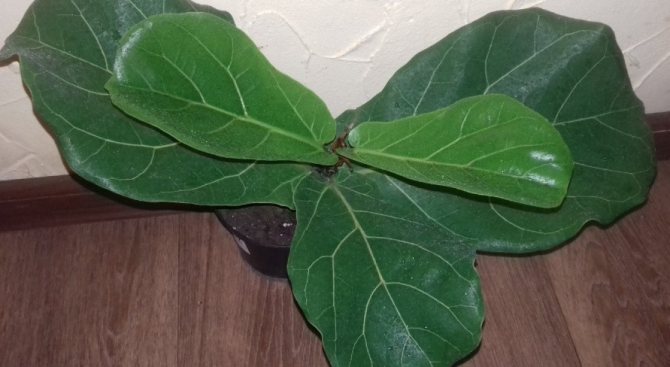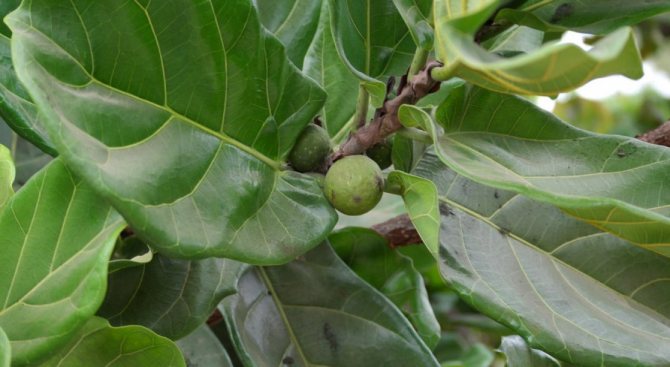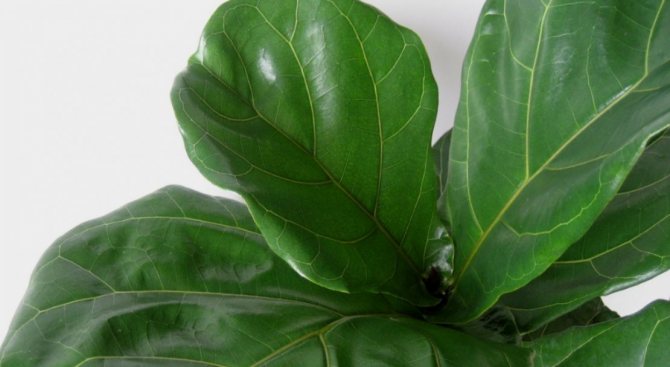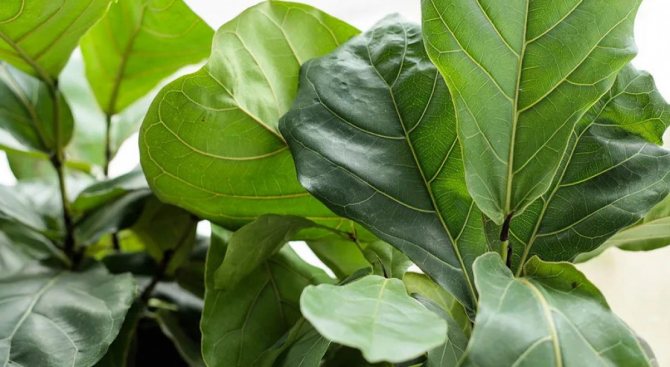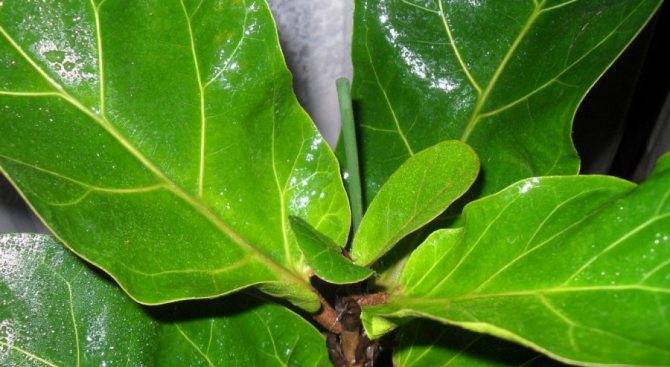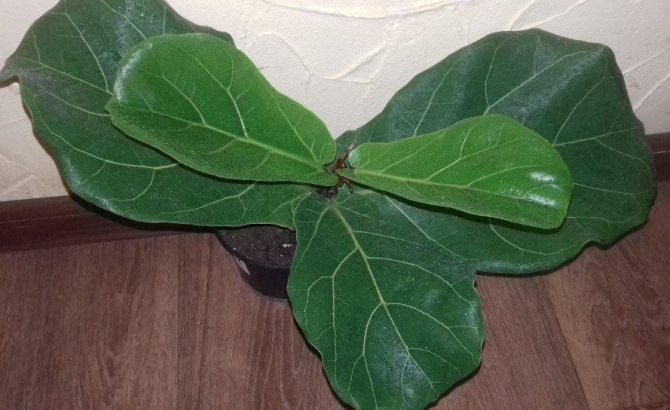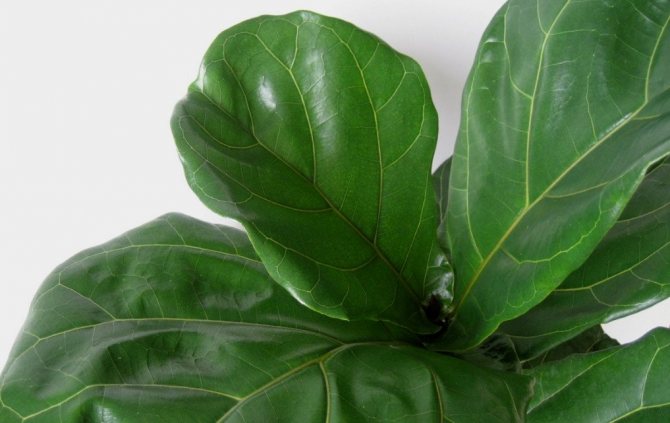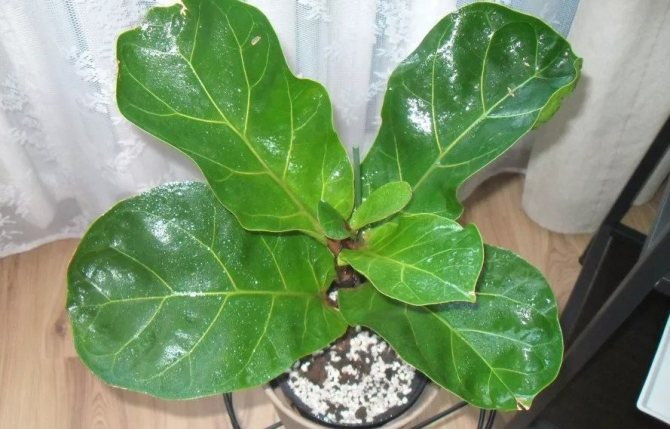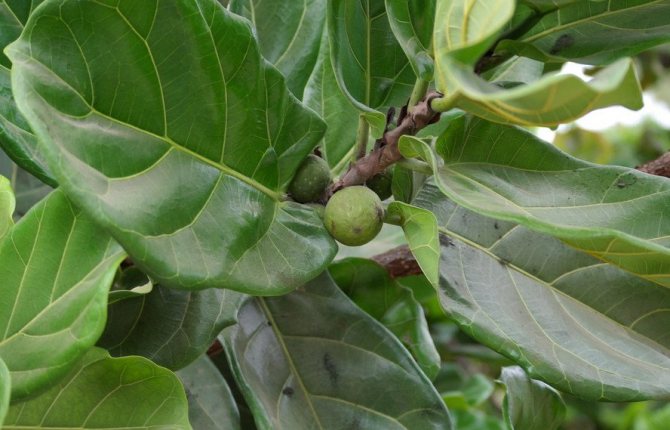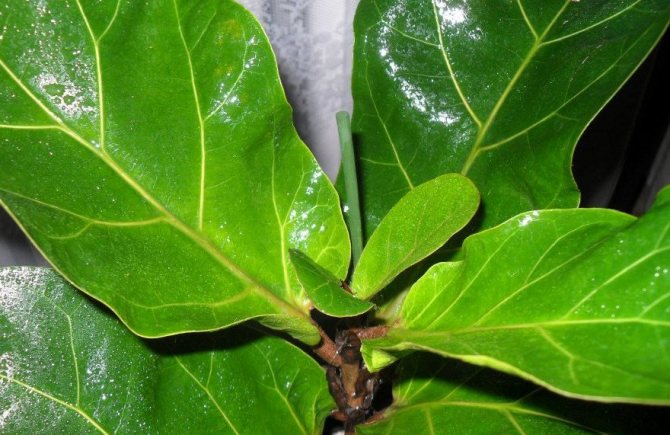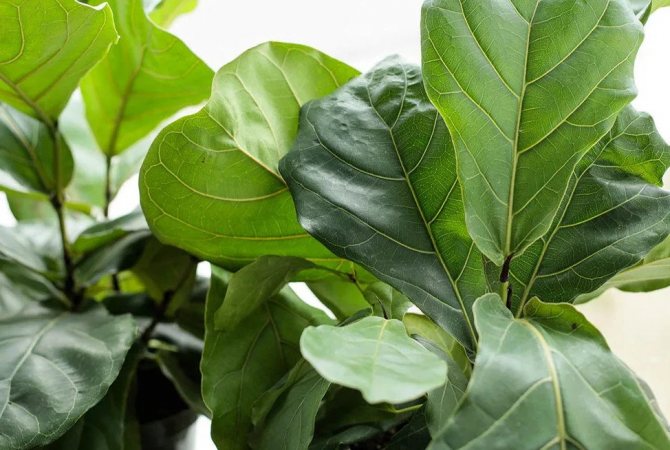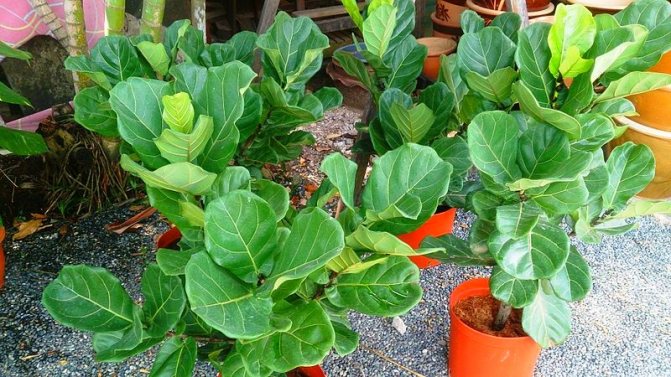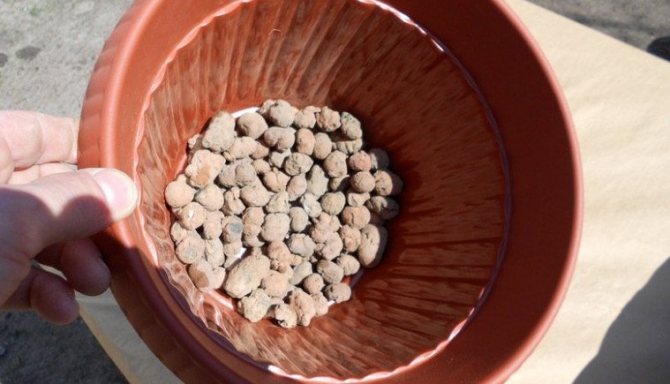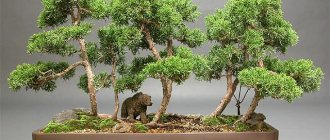Description
The birthplace of the tree is a tropical West African forest.
Ficus lovers should pay attention to these popular varieties.
Bambino
The plant forms a compact crown and densely arranged leaves that grow up to 24 cm.
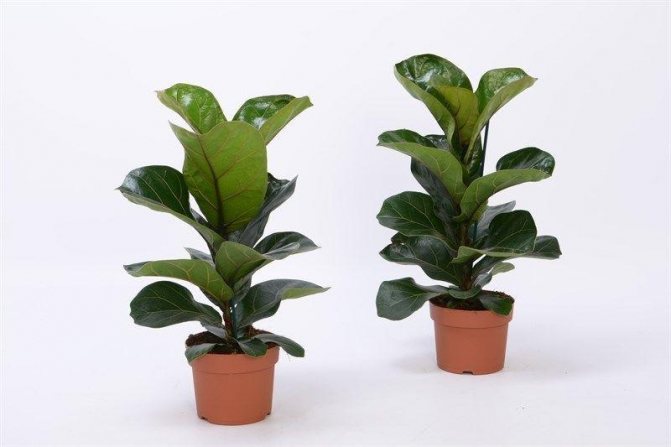
Bambino
Phyllis Craig
The variety was bred in 1956. It has a compact crown, the leaves reach a length of 34 cm.
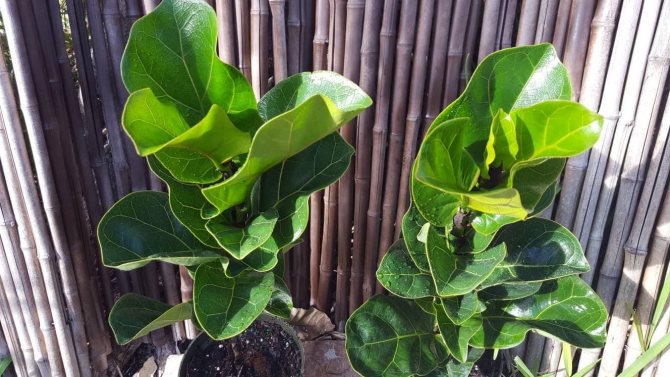

Phyllis Craig
Lyre ficus has a positive effect on the energy of the house, improves mood. Since ancient times, it has been noticed that people who grow this tree in their homes are less likely to get sick and recover faster.
In order for family relations to be harmonious, as well as to add a family, it is believed that a flowerpot with ficus should be placed in the bedroom.
Appearance and characteristics
Ficus lyre, or ficus lyrata, is an evergreen plant. Indoors, its height usually does not exceed 2-2.5 meters. The trunk of the ficus is straight and rough, has a gray color.
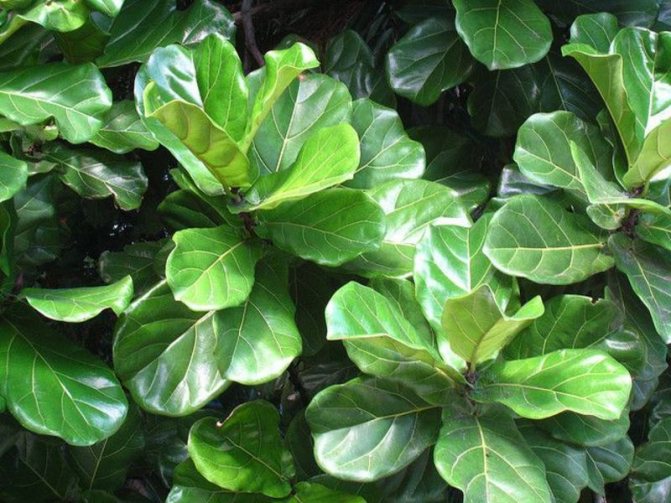

The leaves of the plant are large (up to 45 cm in length), dense and leathery. The edges of the leaf plates are slightly wavy. In the middle, the sheet is, as it were, slightly pulled together and has lighter veins, reminiscent of strings. The plant usually has few branches.
On each branch, several leaves on short petioles are arranged in a spiral. Bengal ficus has thinner and softer leaves. In the wild, you can see the fruits of the ficus, which are rounded, small in size and green in color.
Among the plant varieties, the most popular are:
- Columnaris - most often it is grown in conservatories, foyers and halls of large buildings. The flower is columnar and tall.
- Little Fiddle - Often bred in offices. It has an average height (up to 1 meter).
- Bambino is the most convenient for home breeding, as it is small in size.
How to care for lyre ficus at home?


When choosing a location, you should give preference to placement near the window. The plant needs high humidity, but when the soil substrate is waterlogged, brown spots appear on the surface of the leaves, then the leaf blades fall off. Lyre ficus leaves should be regularly wiped with a damp, soft cloth.
When taking care at home, the optimal temperature regime should be in the range of + 18 ... + 24 degrees. A young tree is transplanted in the spring, when the roots become cramped in their pot. Ficus, which is older than 4 years old, is transplanted once every 3 years.
First, you need to cut off rotten and broken roots. The new pot should be 20% larger than the previous one. For a large plant, you need to buy a stable heavy container.
The ripe tops of the shoots should be cut off once a year. In winter, the plant needs additional lighting; the room needs to maintain a temperature of about +15 degrees.
Growing conditions
Lyre ficus is a demanding indoor plant. He is too capricious and, under the wrong growing conditions, the flower can shed its leaves and lose its decorative qualities.
Read more about what should be the composition of the soil for the ficus.
It is necessary to monitor the following processes:
- correct placement;
- humidity;
- lighting;
- the temperature of the content;
- the temperature of the soil in the pot.
Placement and lighting
Exot requires sufficient lighting, without direct rays hitting the leaves. The flower must be placed in the western and eastern parts of the room. If you place a flower in the northern part, there will be a lack of sunlight, and in the southern part there will be an excess. In winter, it is required to illuminate the plant with additional means.
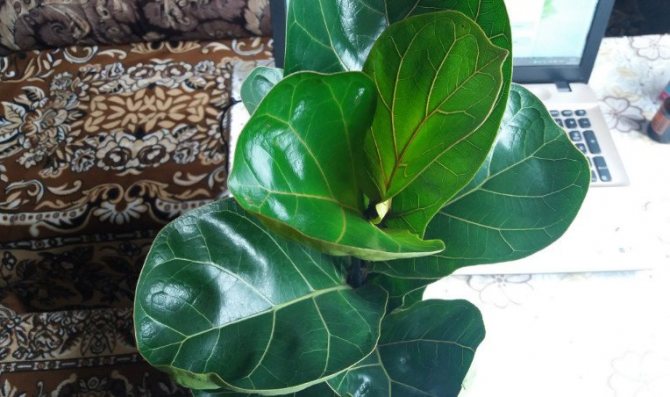

Temperature and humidity
The temperature for growing a flower in summer should be + 20 ... + 25 ℃, and in winter - + 15 ... + 20 ℃.
Important! In winter, the flower can withstand temperatures up to + 12 ℃, while it is worth reducing watering. With a little watering, the flower can exist at a temperature of + 10 ℃, but not for long.
Ficus is bad for temperature changes, if there are sudden temperature changes, spots will appear on the leaves. It is also necessary to monitor the temperature of the soil in which the ficus is located, it should not overcool. In winter, it is better to place the plant near the battery, since the flower is thermophilic, does not tolerate cold and drafts.
If it is not possible to put the plant near the battery, the pot must be wrapped in a warm cloth and watering must be kept to a minimum. Humidity should be at 70%. If this indicator is too low in the room, the flower can be moistened by spraying, wiping the leaves with a damp cloth, or placing a container of water next to it.
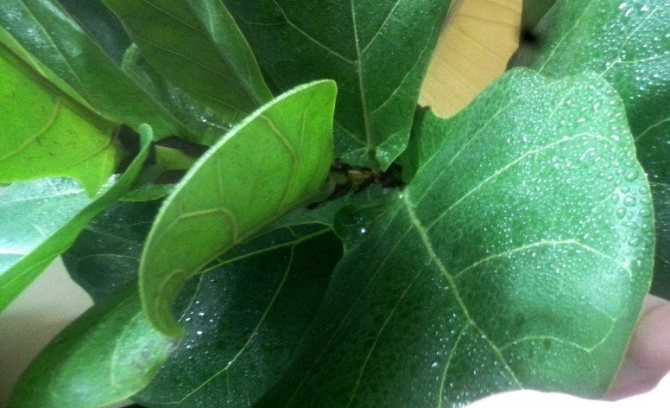

Leaves turn yellow and fall: what to do?
The reasons for this phenomenon:
- Change of temperature, irrigation, light conditions.
- The pot does not match the size of the ficus.
- Nutrient deficiency.
Solutions:
- The flowerpot should be in a permanent place, it cannot be transferred from a warm place to a cold one.
- It is recommended to transplant no more than 1 time a year.
- Avoid direct sunlight, and in winter, arrange additional illumination with special lamps.
- The new capacity should be 20% larger than the previous one.
- Ficus is fed with complex fertilizers.


Crown formation and pruning
The main purpose of pruning lyre ficus is to stimulate the formation of lateral shoots. When the tree reaches a height of 70 cm, the top is cut off above one of the internodes. Thick shoots should be cut obliquely, thin shoots straight. A knife or razor needs to be sharpened and disinfected.
Other ways to form a crown:
- pinching the top - one sprout is formed;
- the top is bent to the ground surface and fixed. After the formation of lateral shoots, the plant is returned to its original position;
- the tree trunk needs to be pierced by a third with a needle to stimulate the formation of additional shoots.
Fight against diseases and pests when caring for lyre ficus
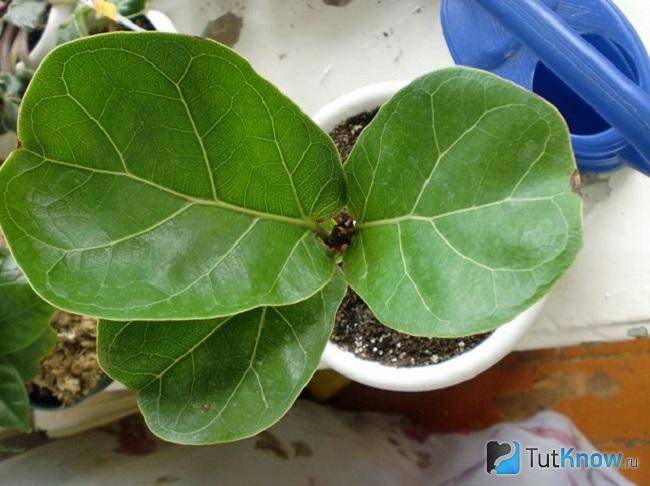

Like many representatives of this genus, the violin ficus will be affected by harmful insects that will suck nutritious juices from the leaves. Such pests are:
- Mealybug
, forming whitish lumps, similar to pieces of cotton wool, attached to the back of the leaves and between their nodes. Also, soon, parts of the plant will be covered with a sugary sticky bloom, called padya - these are the waste products of insects. If you do not remove such plaque, then it will cause a fungal disease - a sooty fungus. In this case, the entire surface of the leaves and branches will have a grayish-black color, which, when touched, will remain on the fingers and will resemble soot. - Shield
manifests itself in the form of shiny small brownish-brown plaques, which are clearly visible from the back of the leaves; the already mentioned pad is present. - Spider mite
sucks vital juices from the foliage, piercing it at the same time. Along the edge, you can distinguish multiple, like needle punctures, and a thin cobweb begins to cover the leaf, which can also be seen on the branches.At the next stage, the foliage changes its color to yellow and falls off, if measures are not taken, then the cobweb will spread to other parts of the plant, and it may even die.
To begin with, it is recommended to wash the lyre-shaped ficus under a warm shower, but before that, the soil in the pot is covered with a plastic bag. After all the foliage has been thoroughly washed, it should be wiped off with one of the non-aggressive solutions, with which you can remove a certain amount of harmful insects. There are many such "folk" drugs, but here are just a few:
- Soap is made on the basis of laundry soap (300 grams is dissolved in a bucket of water) or any other dishwashing detergent.
- The oily composition can be made from rosemary essential oil (5 drops per liter of water).
- Alcohol can be a pharmacy tincture of calendula.
Any of these preparations is applied to a soft cloth and the leaves are carefully wiped on both sides. But these are not all the steps - the main one is the treatment with insecticidal and acaricidal agents, among which Aktara, Actellik or Fitover are recommended.
With frequent violation of the conditions of detention, lyre ficus can respond with the following symptoms:
- Yellowing and foliage shedding occurs when the substrate is excessively wet, a sharp drop in temperature, a decrease in humidity, or under the influence of a draft.
- When infected with fungal diseases caused by frequent floods of soil, the plant forms brown dots and black spots on the leaves. Treatment with fungicidal preparations will be required.
- Lack of light can lead to strong stretching of the shoots.
- Foliage becomes shallow due to lack of nutrients in the soil.
How to transplant?
After purchase, lyre ficus undergoes adaptation for 2 weeks. For planting, use a special soil substrate. Initially, the roots should be completely cleaned of the transport soil. The pot is purchased based on the size of the root system. To facilitate the regulation of the irrigation regime, a drainage layer is poured onto the bottom of the pot.
Lyre ficus is transplanted in the spring (in April). The pot is selected with a diameter of 2 fingers larger than the previous one, the optimal material for making the container is clay.
How to propagate lyre ficus?
Best propagated by apical cuttings. To do this, ¾ of the area of the leaf blade must be cut to prevent moisture evaporation. The stalk is placed in a container with water, after 30 days the roots are formed. After that, the seedling is planted in a pot with a soil substrate.
Also, the tree is propagated by air layers. To do this, remove leaves on a growing shoot (lateral or central) 15-25 cm long, leaving 1-2 pieces and a growth bud. The length of the bare section should be about 10 cm. A notch is made under the leaf node located in the center of the section. Wrap this place with pre-soaked moss, on top with a polyethylene film, fix the edges with wire. After the formation of roots, the shoot is cut off, planted in a special soil substrate.
Reproduction methods
There are several ways to propagate ficus bambino at home. The most convenient and effective way to do this is with cuttings and layering. Propagation by cuttings is carried out as follows:
- In an adult plant, a cutting 10-15 cm long is cut. It should have several leaves, which are cut in half to reduce evaporation.
- Milky juice appears at the cut site. It must be washed off with water. The stalk is left to dry for several hours.
- In a small container with water, the root is bred and the cutting is lowered there. From above, the container is covered with a film.
- The first roots of the shoot will appear in a month. Now you can plant a young plant in a pot.
Another way to breed lyre ficus is leaf propagation.You can use a single leaf, or you can cut it off along with the bud - this way the plant will develop better. The algorithm of actions for propagation by a leaf is the same as for cuttings.
Reproduction using seeds is extremely rare at home. This process is laborious and not always effective. You need to germinate seeds at a temperature not lower than +25 degrees. The seedlings will be ready 2-3 months after sowing.
You can propagate ficus using layering. The algorithm of actions in this case should be as follows:
- A suitable shoot is selected and an incision is made on it with a sharp knife. The bark is removed on an area 2 cm wide.
- The exposed area is treated with a rooting solution and covered with wet moss. Sphagnum (special moss) can be purchased at specialized stores. A layer of moss is wrapped on top with cling film or plastic bag. This will create a greenhouse effect.
- The plant is left alone for 2 to 3 months. Roots will form at the incision site. After their appearance, the moss is unfurled and the shoot is cut a little lower.
- The resulting cuttings are planted in a pot of soil.
How to properly grow and water an orchid at home
The soil for planting young plants should be light, well saturated with air and moisture. You can buy it at the store or prepare it yourself. For this, river sand is mixed with perlite or coconut flakes. At first, the plant must be kept in a greenhouse, where the air temperature is maintained at +25 degrees. It is necessary to regularly moisten the soil and ventilate the greenhouse.

